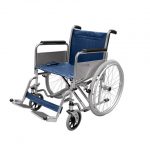It's official, obesity is on the increase and the average weight of both adults and children is swelling ! As obesity becomes an international problem, wheelchair manufacturers around the world have adapted the design and materials used in building wheelchairs. Bariatric wheelchairs have been designed specifically to address the needs of obese folk who can grow to weights in access of 80 stone and prefer to maintain some level of mobility.
You can see our range of heavy duty bariatric wheelchairs here
To address these vast weights several changes have had to be made to the standard wheelchair to ensure they can cope with the load plus the knocks and bumps most wheelchairs encounter. Bariatric or heavy duty wheelchairs are important because they have special features that not only cater for larger weight capacities but also accommodate increased width and depth that comes with the increase in overall size. The aim, is to make the user as comfortable as is possible. Today, a wide variety of bariatric or heavy duty wheelchairs are available with wider stronger frames and wheels with solid tyres to avoid puncture.
Considerations when selecting a heavy duty or bariatric wheelchair:
Your weight
Plan for the future and don't compromise this. Make sure you select a wheelchair that meets your maximum weight limits including any items you are likely to carry with you. Factor in a margin for safety and growth. We sell wheelchairs with weight limits up to and including 250 KG's or a quarter of a tonne.
Wheelchair seat width
To do this best have someone measure you whilst seated and once you have your size, add about two inches for comfort. We sell bariatric wheelchairs with seat widths up to 30".
Wheelchair seat height
This can best be calculated by sitting down and ensuring that your feet are placed flat on the floor whilst your shins are perpendicular to the ground. From here, measure the length from your heel to the back of your knee. This is best done by an assistant and is important to get right for long term comfort.
Wheelchair seat depth
Again while seated, measure the distance from your hip to the back of your knee then add 3 inches to ensure comfort. This is more important if you are likely to spend long periods in your wheelchair. Cushions can also be considered here to ensure you are comfortable supported in all areas.
Backrest height
As the backrest affects your posture its important to get this right. The rule of thumb is to have a backrest that provides support right to the top. The top of the backrest should be approximately the same height as your shoulder blades when sat upright.
Armrest height
The height of the armrest is best calculated by measuring the length from the seat to your flexed forearm. Ensure that your forearm is perpendicular to your backrest while sitting upright and take the measurement at this point. Again this is best carried out by an assistant to get an accurate measurement.
Specialist reclining bariatric wheelchairs
For those users with breathing difficulties while in an upright seated position or those who have other types of respiratory illnesses, there are bariatric or heavy duty wheelchairs that recline which takes the pressure off internal organs. This is a very specialist requirement and we advise you seek advice from your GP. For those users who have heart problems or do not have the strength to propel themselves, bariatric wheelchair powerpacks and powered electric wheelchairs are also available
We hope you have found these pointers useful but do stress that professional advice is best taken.

